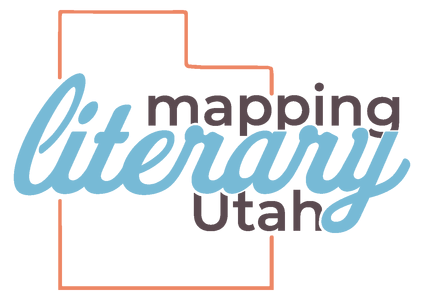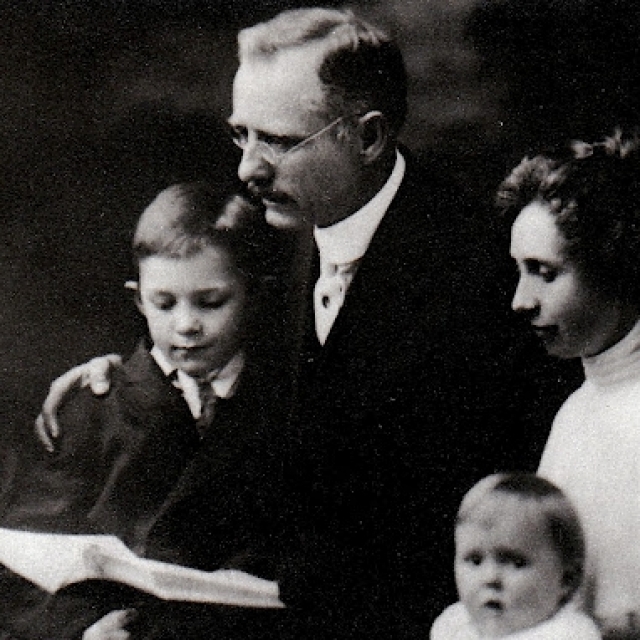Writer and educator Nephi Anderson was born in the Vestre Toten municipality of Christiana (the city now called Oslo), Norway on January 22, 1865. His parents were recent converts to the Church of Jesus Christ of Latter-day Saints, and when Anderson was only six years old, the family immigrated to the United States with their six young children to join the LDS community in the Utah Territory. Anderson’s parents settled in Coalsville, and later moved to Ogden, where Anderson would later attend school, marry his wife Asenoth Tillotson, and begin teaching in schools across Ogden and Brigham City.
Anderson served a two-year mission for the LDS Church in Norway from 1891-1893, and a second mission in Great Britain after Asenoth died in 1904. When he returned to Utah, Anderson remarried, raising six additional children with his second wife Maud Rebecca Symons. Anderson died on January 6, 1923 after complications from surgery for appendicitis, and several prominent members of the LDS Church spoke at his funeral, citing both his exemplary service and his strong ideals.
Over the course of his career, Anderson worked as a teacher, a school superintendent, a missionary, an editor, and a librarian as well as a writer. During his early years of teaching, he would save his summers and Christmas vacations to write for The Contributor, an LDS periodical; likewise, while on his missions to Norway and Great Britain, Anderson kept a detailed travel diary that later furnished material for several essays and poems. At various points, Anderson also served as editor for various Church publications: assistant editor of the Millennial Star during his 1904-1906 mission to Great Britain, chief editor of The Liahona in Missouri from 1909-1910, and editor-librarian with the Genealogical Society of Utah from 1910 until his death thirteen years later.
Anderson’s oeuvre includes several novels, short stories, and essays as well as a few poems and other short works. Overall his writing, prepared both during his travels and in various places across the United States, help paint a picture of the LDS Church as a transnational faith and community. Most of Anderson’s works feature LDS characters, utilize LDS-inspired storylines, and treat with themes such as piety and the pioneer spirit: all characteristics that led to popularity and acclaim in Anderson’s home state. A local newspaper, The Box Elder Journal, reported in 1923 that Anderson’s most recognized and well-beloved work, the 1898 novel Added Upon, had been read by nearly everyone in Utah.
Scholarship today places Anderson’s work within the tradition and period titled “Home Literature,” or the second period of works by prominent LDS writers, in which texts tended to be more didactic, inspirational, and published by Church venues. Anderson’s novel Added Upon is often counted as one of the premier examples of this period, and has never been out of print since its initial publication by Deseret News Publishing Company in 1898. This novel also inspired and influenced many consequent works of LDS literature, both for its story (which follows several characters from pre-birth, to mortal lives on Earth, to their eternal lives after death) as well as for its direct, accessible style.
Works
Bibliography
Fiction
• Dorian, Bikuben Publishing Company, 1921
• The Boys of Springtown, Zion's Printing and Publishing Company, 1920
• Romance of a Missionary, Zion's Printing and Publishing Company, 1919
• John St. John: A Story of Missouri and Illinois, Zion's Printing and Publishing Company, 1917
• A Daughter of the North, De Utah-Nederlander Pub. Co., 1915
• Story of Chester Lawrence, Deseret News Publishing Company, 1913
• Piney Ridge Cottage: The Love Story of a Mormon Country Girl, Deseret News Publishing Company, 1912
• The Castle Builder, Deseret News Publishing Company, 1902
• Marcus King, Mormon, Deseret News Publishing Company, 1900
• Added Upon, Deseret News Publishing Company, 1898
Novellas
• "Almina," The Contributor, 1891–92
• “Fisherman Knute’s Christmas Gift," Improvement Era, 1903
• “Beyond Arsareth," The Relief Society Magazine, 1919-1920
Non-Fiction
• "A Day With Carry Nation," Improvement Era, 1911
• "The Place of Genealogy in the Plan of Salvation," Genealogical Society of Utah, 1911
• "The Larger Nationality," Millennial Star 68.10, 1906
• "Are We Americans?" Improvement Era, 1900
• "Seeing the Midnight Sun" Improvement Era 1.2, 1898
• "Purpose in Fiction," Improvement Era 1, February 1898
• "A Plea for Fiction," Improvement Era 1, January 1898
• A Young Folks' History of the Church, Deseret Sunday School Union, 1889
• ”Beyond the Arctic Circle," Deseret News, 1895
Short Stories (various venues)
• "Exceptions," 1923
• "Distance Lends Enchantment," 1922
• "The Straw," 1922
• "The Girl," 1921
• "Forfeits," 1918
• "At St. Peter's Gate," 1917
• "Tendrilla," 1917
• "Mother's Day," 1916
• "Testing of Gilda," 1916
• "Unbidden Guests," 1915
• "The Home Field," 1915
• "John Engleman and the Spirit of Christmas," 1911–12
• "The Home Guard," 1911
• "Little Child Shall Lead Them," 1910
• "Out of the Abundance of the Heart," 1910
• "End of the Rainbow," 1910
• "How the Lord Was Good to Aunt Johanna," 1909
• "The Inevitable," 1907
• "When the Stove Smoked," 1907
• "Freedom of Donald Gray," 1906
• "Missionary's Release," 1905
• "Christmas Story on Faith, Hope, and Charity," 1904
• "Finding of Olga: A Pioneer Story," 1901
• "Salvation of Souls," 1900
• "Cat-tail Farm," 1894
• "Conscience from Carthage," 1894
• "On the Border-land of Light," 1894
• "Tallie, Bill White's Girl," 1894
• "The Finding of the Pearl," 1894
• "Mary, A Story of Sagebrush Bench," 1891
• "Lester Amsden's Love," 1890
• "Grandmother's Rocking Chair," 1890
Poetry (various venues)
• "The Home Call," 1906
• "Love's First Conquest," 1904
• "A Vision," 1901
• "Died in the Field," 1901
• "Consolation," 1900
• "The Visit of the King," 1895
Links
Nephi Anderson on Project Gutenberg

